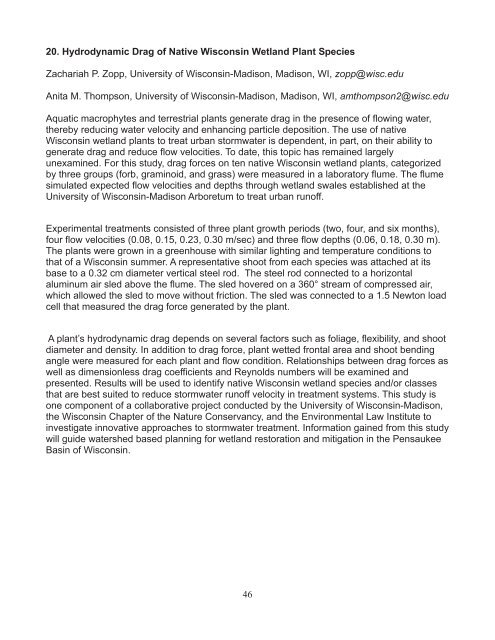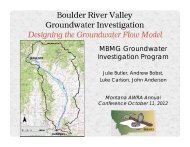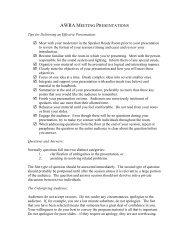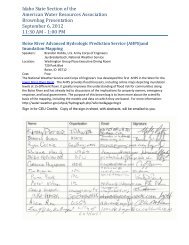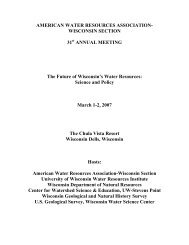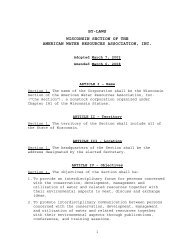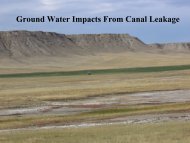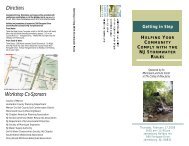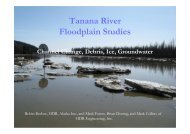Wisconsin's Role in Great Lakes Restoration - American Water ...
Wisconsin's Role in Great Lakes Restoration - American Water ...
Wisconsin's Role in Great Lakes Restoration - American Water ...
Create successful ePaper yourself
Turn your PDF publications into a flip-book with our unique Google optimized e-Paper software.
20. Hydrodynamic Drag of Native Wiscons<strong>in</strong> Wetland Plant Species<br />
Zachariah P. Zopp, University of Wiscons<strong>in</strong>-Madison, Madison, WI, zopp@wisc.edu<br />
Anita M. Thompson, University of Wiscons<strong>in</strong>-Madison, Madison, WI, amthompson2@wisc.edu<br />
Aquatic macrophytes and terrestrial plants generate drag <strong>in</strong> the presence of flow<strong>in</strong>g water,<br />
thereby reduc<strong>in</strong>g water velocity and enhanc<strong>in</strong>g particle deposition. The use of native<br />
Wiscons<strong>in</strong> wetland plants to treat urban stormwater is dependent, <strong>in</strong> part, on their ability to<br />
generate drag and reduce flow velocities. To date, this topic has rema<strong>in</strong>ed largely<br />
unexam<strong>in</strong>ed. For this study, drag forces on ten native Wiscons<strong>in</strong> wetland plants, categorized<br />
by three groups (forb, gram<strong>in</strong>oid, and grass) were measured <strong>in</strong> a laboratory flume. The flume<br />
simulated expected flow velocities and depths through wetland swales established at the<br />
University of Wiscons<strong>in</strong>-Madison Arboretum to treat urban runoff.<br />
Experimental treatments consisted of three plant growth periods (two, four, and six months),<br />
four flow velocities (0.08, 0.15, 0.23, 0.30 m/sec) and three flow depths (0.06, 0.18, 0.30 m).<br />
The plants were grown <strong>in</strong> a greenhouse with similar light<strong>in</strong>g and temperature conditions to<br />
that of a Wiscons<strong>in</strong> summer. A representative shoot from each species was attached at its<br />
base to a 0.32 cm diameter vertical steel rod. The steel rod connected to a horizontal<br />
alum<strong>in</strong>um air sled above the flume. The sled hovered on a 360° stream of compressed air,<br />
which allowed the sled to move without friction. The sled was connected to a 1.5 Newton load<br />
cell that measured the drag force generated by the plant.<br />
A plant’s hydrodynamic drag depends on several factors such as foliage, flexibility, and shoot<br />
diameter and density. In addition to drag force, plant wetted frontal area and shoot bend<strong>in</strong>g<br />
angle were measured for each plant and flow condition. Relationships between drag forces as<br />
well as dimensionless drag coefficients and Reynolds numbers will be exam<strong>in</strong>ed and<br />
presented. Results will be used to identify native Wiscons<strong>in</strong> wetland species and/or classes<br />
that are best suited to reduce stormwater runoff velocity <strong>in</strong> treatment systems. This study is<br />
one component of a collaborative project conducted by the University of Wiscons<strong>in</strong>-Madison,<br />
the Wiscons<strong>in</strong> Chapter of the Nature Conservancy, and the Environmental Law Institute to<br />
<strong>in</strong>vestigate <strong>in</strong>novative approaches to stormwater treatment. Information ga<strong>in</strong>ed from this study<br />
will guide watershed based plann<strong>in</strong>g for wetland restoration and mitigation <strong>in</strong> the Pensaukee<br />
Bas<strong>in</strong> of Wiscons<strong>in</strong>.<br />
46


